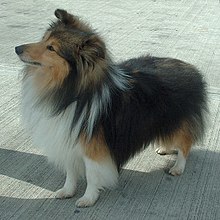| Shetland Sheepdog | |||||||||||||||||||||||||||||
|---|---|---|---|---|---|---|---|---|---|---|---|---|---|---|---|---|---|---|---|---|---|---|---|---|---|---|---|---|---|
 Sable Shetland Sheepdog | |||||||||||||||||||||||||||||
| Other names |
| ||||||||||||||||||||||||||||
| Common nicknames | Sheltie | ||||||||||||||||||||||||||||
| Origin | Scotland | ||||||||||||||||||||||||||||
| |||||||||||||||||||||||||||||
| |||||||||||||||||||||||||||||
| Dog (domestic dog) | |||||||||||||||||||||||||||||
The Shetland Sheepdog, also known as the Sheltie, is a breed of herding dog that originated in the Shetland Islands of Scotland. It was formally recognized by the Kennel Club in 1909. It was originally called the Shetland Collie, but this caused controversy amongst Rough Collie breeders of the time, so the name was changed.[1] It is a small dog, clever, vocal, willing to please, and trustworthy.
Like the Shetland pony, Shetland cattle, and the Shetland sheep, the Shetland Sheepdog is a hardy but diminutive breed developed to thrive amidst the harsh and meagre conditions of its native islands. While the Shetland still excels at herding, today it is often raised as a working dog or family pet.[2]
The Shetland's origins are obscure, but it is not a direct descendant of the Rough Collie, which it largely resembles. Rather, the Shetland is a descendant of small specimens of the Scottish Collie and the King Charles Spaniel. They were originally a small mixed-breed dog, often only about 20 to 30 centimetres (8 to 12 inches) in height at the shoulder, and it is thought that the original Shetland herding dogs were of the Spitz type, and were crossed with Collies from mainland Britain.[1] In the early 20th century, James Loggie added a small Rough Collie to the breeding stock, and helped establish the breed that would become the modern Shetland Sheepdog.
- ^ a b Herbert, Beryl & Joan (1961). The Shetland Sheepdog. New York, New York: Arco Publishing Company, inc. ISBN 0-668-03976-0.
- ^ "Shetland sheepdog." The Columbia Encyclopedia. New York: Columbia University Press, 2008. Credo Reference. Web. 17 September 2012.